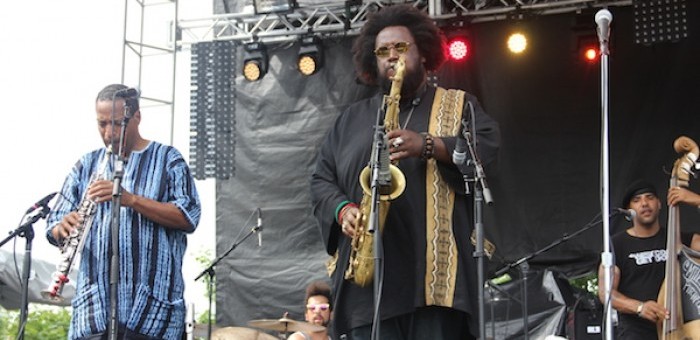Apr 2, 2024 12:59 PM
Saxophonist, Sonic Explorer Casey Benjamin Dies at 45
Casey Benjamin, the alto saxophonist, vocalist, keyboardist and producer who stamped his distinctive sounds on the…

Rickey Washington (left), Tony Austin, Kamasi Washington and Miles Mosley perform at the Pitchfork Music Festival in Chicago on July 17.
(Photo: Brian Zimmerman)In jazz circles, the buzz surrounding the 11th annual Pitchfork Music Festival, which took place July 15–17 at Chicago’s Union Park, was that not one, not two, but three jazz artists had been scheduled to perform on the festival’s final day.
Though hardly earth-shattering, the programming note was a justifiably newsworthy one, given that Pitchfork Media, a bastion of rock and pop criticism, hadn’t allotted such ample time to jazz since the mid-2000s, when appearances by artists such as guitarists Jeff Parker and Nels Cline, reedist Ken Vandermark, trumpeter Rob Mazurek and bassist William Parker were not uncommon.
But if Pitchfork’s programming reflects the listening trends of young, media-savvy music consumers, it makes sense that this year’s festival would mark the triumphant return of jazz, which has witnessed a resurgence among popular audiences of late. And it seems even more logical that Pitchfork Festival’s musical director, the Chicago-based jazz drummer Mike Reed, would mark the genre’s homecoming with three of its most compelling crossover acts: saxophonist Kamasi Washington, bassist Thundercat and the Sun Ra Arkestra.
Though just past the halfway mark, 2016 has been a banner year for Washington. Not only did the saxophonist win the inaugural American Music Prize for Best Debut Album—for his three-disc set The Epic (Brainfeeder)—but he was also named Rising Star–Jazz Artist and Rising Star–Tenor Saxophone in the DownBeat Critics Poll (The Epic also won for Jazz Album of the Year).
Extending his reach into the hip-hop world, Washington served as a collaborator on Kendrick Lamar’s Grammy-winning 2015 album, To Pimp A Butterfly (Top Dawg), a credit that brought widespread exposure to his unconventional genius.
As jazz’s most talked-about artist, Washington was no doubt a presence in the collective musical conscious—if not the playlists—of his audience at Pitchfork, which skewed overwhelmingly young. In front of a packed crowd, he delivered a terse but powerful set of swaggering funk, stormy hip-hop and sinewy jazz that was as musically satisfying as it was emotionally purifying.
In and of itself, Washington’s aesthetic—the Afro-futurist propensities, the sprawling, open-ended musical incantation—is hardly new. As countless critics have pointed out, the saxophonist’s heritage is that of the spiritual jazz-funk vein, with Pharoah Sanders and John Coltrane as obvious precursors. Indeed, his July 17 performance at Pitchfork seemed to point to these early influences. A solo on “Cherokee,” a remake of the Ray Noble standard, found Washington unfurling cascading lines in the upper register, à la Coltrane; and on “Re Run Home,” a dreamy waterfall of an r&b tune, the saxophonist dealt in clean, uncomplicated solo lines that accelerated into pure energy, à la Sanders.
But historical fidelity isn’t Washington’s only appeal, and while his music draws freely from the past, it also engages in a sharp and artistically fruitful examination of the present. Washington’s musical appetite represents a mystifying confluence of styles and sounds, both modern and traditional, which is why watching his set at Pitchfork was like watching two strains of musical phenomena converge. Through his tantric musical persona, the cathartic, mind-loosening repetitiveness of current hip-hop and the organic, improvised reactiveness of jazz collude into one stream.

Benjamin possessed a fluid, round sound on the alto saxophone, and he was often most recognizable by the layers of electronic effects that he put onto the instrument.
Apr 2, 2024 12:59 PM
Casey Benjamin, the alto saxophonist, vocalist, keyboardist and producer who stamped his distinctive sounds on the…

“He’s constructing intelligent musical sentences that connect seamlessly, which is the most important part of linear playing,” Charles McPherson said of alto saxophonist Sonny Red.
Feb 27, 2024 1:40 PM
“I might not have felt this way 30 to 40 years ago, but I’ve reached a point where I can hear value in what people…

Albert “Tootie” Heath (1935–2024) followed in the tradition of drummer Kenny Clarke, his idol.
Apr 5, 2024 10:28 AM
Albert “Tootie” Heath, a drummer of impeccable taste and time who was the youngest of three jazz-legend brothers…

“Both of us are quite grounded in the craft, the tradition and the harmonic sense,” Rosenwinkel said of his experience playing with Allen. “Yet I felt we shared something mystical as well.”
Mar 12, 2024 11:42 AM
“There are a few musicians you hear where, as somebody once said, the molecules in the room change. Geri was one of…

Larry Goldings’ versatility keeps him in high demand as a leader, collaborator and sideman.
Feb 21, 2024 10:45 AM
Are you having any fun? Larry Goldings certainly is. Consider just two recent examples:
Scene 1: “If anyone had…